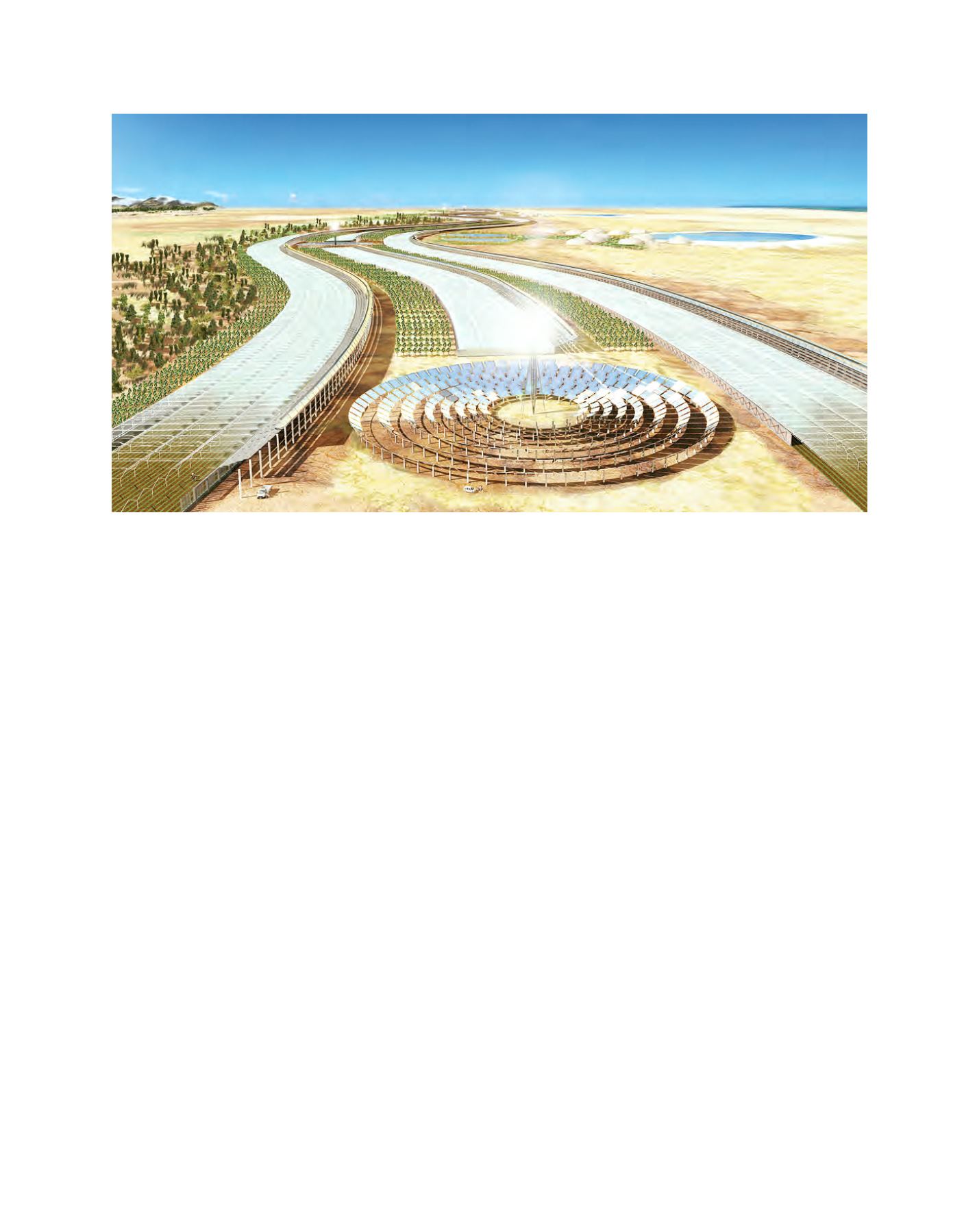

[
] 283
a traditional desalination facility integrated with the Sahara Forest
Project facility. This could deliver an additional supply of freshwater
to greatly extend the potential for revegetation.
The saltwater-based greenhouses are combined with Concentrated
Solar Power (CSP) facilities. CSP is widely considered as one of the
renewable energy technologies with the highest potential for rapid
deployment and impact on the global energy mix. CSP systems use
mirrors to concentrate the energy from the sun and create very high
temperatures which produce superheated steam that can power a
conventional steam turbine.
The Sahara Forest Project proposes to combine CSP facilities with
a salt water infrastructure to achieve highly beneficial synergies:
• Salt water can be used for cooling of CSP, increasing the power
production
• Both the new outside vegetation and the greenhouse structures will
provide dust arresting. The outside vegetation will also stabilize
ground conditions. Less dust in a CSP field means more sun
reaching the mirrors and less dust settling on the reflecting surfaces
• Freshwater from the greenhouse facilities can be used for
cleaning of the mirrors
• Electricity from the CSP facility can be used for running pumps
and greenhouse equipment
• The waste heat from the CSP facility can be used for evaporating
more water vapour from seawater that can be distilled back into
freshwater.
In contrast to most traditional desalinisation facilities, the Sahara
Forest Project operates without emissions of brine back to the sea.
As the water is evaporated from salt water the salinity increases to
the point that the salts precipitate out from the brine. The extrac-
tion of the minerals from seawater is an alternative to mining them
from the ground. The largest component is table salt (NaCl) that has
many uses and is valuable as an industrial feedstock.
From vision to reality
In January 2011 a memorandum of understanding
was signed between the Aqaba Special Economic Zone
Authority and the Sahara Forest Project in Amman,
Jordan. This agreement committed the Sahara Forest
Project to conducting three comprehensive studies in
Jordan financed and supported by Norwegian authorities.
The ongoing studies will prepare for the construction of
a Sahara Forest Project Test and Demonstration Centre,
located in Aqaba, Jordan. The memorandum also states
that the Aqaba Special Economic Zone Authority will
facilitate the necessary land area for the Sahara Forest
Test and Demonstration Centre, including a corridor for
the salt water pipe from the Red Sea to the Centre. The
initial area needed for the Centre will be 20 hectares.
ASEZA will also assist the Sahara Forest Project in
identifying and securing 200 hectares for possible later
expansion.
The Sahara Forest Project has also entered into coop-
eration with Yara ASA, the world’s largest supplier of
fertilizer, and the Qatari company Qafco, the world’s
largest single-site producer of urea and ammonia. The
first step of the cooperation is for the Sahara Forest
Project to conduct a comprehensive feasibility study
in Qatar. Yara and Qafco are committed to provid-
ing finance, knowledge and technical support to the
Sahara Forest Project in these studies. As an example,
Yara and Qafco will contribute scientifically on how
to create an environmentally friendly fertilizer for the
greenhouses, as well as a special fertilizer for use in
desert areas.
The landscape of Qatar consists mainly of relatively
flat and low-lying arid land. The climate is characterized
A large-scale roll out of the Sahara Forest Project could give rise to new growth in desert areas
Image: The Sahara Forest Project
















